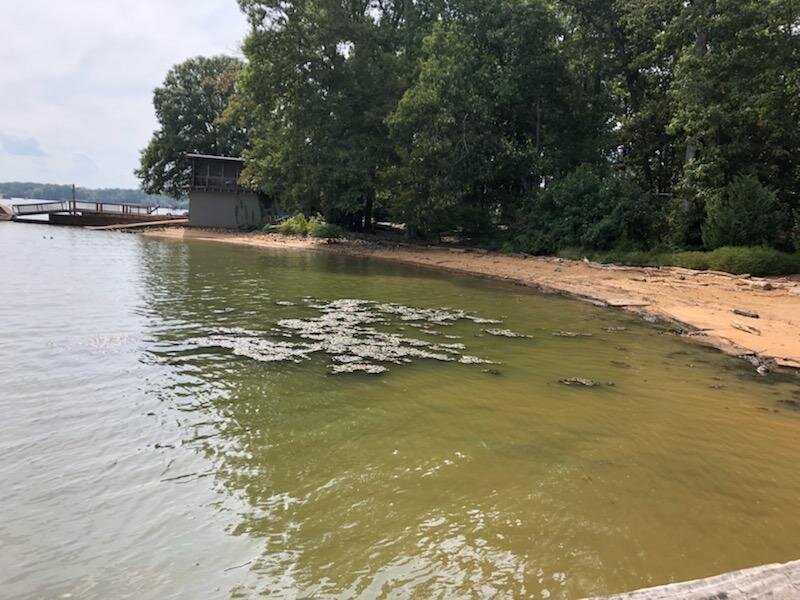Yadkin Riverkeeper Comments Docket ID No. EPA-HQ-OW-0463
Agency Policy for Determining if Harmful Algae Blooms or Hypoxia Event in Freshwater is an “Event of National Significance.”
Photo by Alisa Slemp Johnson
The Yadkin Riverkeeper is a 501(c)(3) organization based in Winston-Salem, NC. The organization is affiliated with the Waterkeeper Alliance. Our mission is to protect and enhance the Yadkin River in the central and northwest Piedmont region of North Carolina. The Yadkin River watershed is the second largest river basin in the state and encompasses more than 7,200 square miles and includes more than 5,800 miles of streams and almost 23,000 lake acres. The seven man-made lakes, including High Rock Lake (HRL), in the central Piedmont, are important recreational resources for the nearly 2 million people living in the watershed. The River flows through 21 counties and more than 90 municipalities and serves as the drinking water source for almost 1 million people with nearly 200,000,000 million gallons per day withdrawn for drinking water and commercial and industrial uses.
Most of the lakes in the basin have experienced a significant number of HABs, with more than 250 harmful algae blooms (HABs) reported from 2012-2018. In September 2019, officials with the Davidson and Rowan County Health Departments issued public swim advisories in response to positively identified blooms of Lyngbya wollei in HRL. While the state has documented previous cyanobacteria HABs in HRL, these were the first swim advisories issued. Based on data published by Cube Hydro Carolinas, the federal licensee managing the lakes, Tuckertown Reservoir averaged 58 percent coverage with L. wollei from 2015-18 and Badin Lake saw L. wollei coverage ranging from six to 38 percent during that same period. The NC Department of Environmental Quality also documented a cyanobacteria bloom in the Kerr Scott Reservoir in Wilkes County earlier this year. The problem of HABs in the Yadkin River basin and especially its lakes, is clearly widespread and threatens the use of the River and lakes for recreational purposes and drinking water.
Yadkin Riverkeeper offers the following recommendations for determining if a HAB or hypoxia occurrence in freshwater should be considered an issue of national significance.
1) Impacts drinking water supplies.
2) Limits the use of public recreational waters.
3) Impacts or potentially could impact humans.
4) Adversely affects fisheries, wildlife populations or domestic animals.
5) Is determined to cover a significant percentage of the water body as documented by spectral and aerial surveys.
Regarding the toxicity of algae blooms, YRK recommends the use of EPA’s proposed standard for cyanotoxins as a threshold for determining a nationally significant event, particularly if any human or animal health impacts have been associated with the HAB. Unfortunately, North Carolina and many other states do not currently have the capacity to test for some cyanotoxins on a case-by-case basis, much less a regular basis. States and local government agencies need resources, protocols and assistance in developing and implementing cost effective, real time tests for cyanotoxins when HABs have been identified.
Algae researchers from North Carolina State University have also found multiple cyantoxins associated with HABs in HRL, including microcystins, cylindrospermopsin and anatoxins, albeit in very low concentrations. Regardless, the presence of multiple cyanotoxins and the uncertainty associated with the cumulative impacts of multiple cyanotoxins, should warrant consideration as criteria for determining nationally significant HABs.
The size, frequency and potential for spreading should be taken into account when assessing the significance of HABs. Efforts have been underway the past several years to assess the coverage of L. wollei blooms in Tuckertown and Badin reservoirs. This will now be extended to HRL. As noted above, coverages and blooms have varied year-to-year, but coverage of more than 20 percent for a multi-year period, should warrant the consideration of a nationally significant event.
In terms of the economic impacts, the recreational lakes and the River have a significant impact on local economies. HABs have the potential to reduce property values reducing local property tax revenues. Potential contamination of drinking water supplies, which there have been at least three cases of in North Carolina, can significantly increase water treatment costs. Lastly, HABs have had serious impacts on recreational uses, including swimming, boating and fishing, costing local seasonal economies millions of lost tourism and recreation dollars.
More research is needed on the environmental transport/fate and human health effects of cyanotoxins to set criteria for determining which HABs are nationally significant events. The correlation between cyanotoxins and hypoxia should be further examined, including potential cumulative impacts on aquatic systems and human health. The complex interactions of nutrients, climate and HABS cannot be understated and should be studied further to provide guidance to state and local environmental and health agencies to allow them to better educate the public on the relative risk of HABs.
In conclusion, Yadkin Riverkeeper encourages EPA to move forward with developing criteria for determining when HABs should be considered an event of national significance. In doing so, we recommend the agency look at the ubiquitous nature of HABs around the country and works towards a national policy that takes into account regional variability, while adhering to strong water quality and public health protections.
Edgar Miller
Executive Director
Yadkin Riverkeeper

